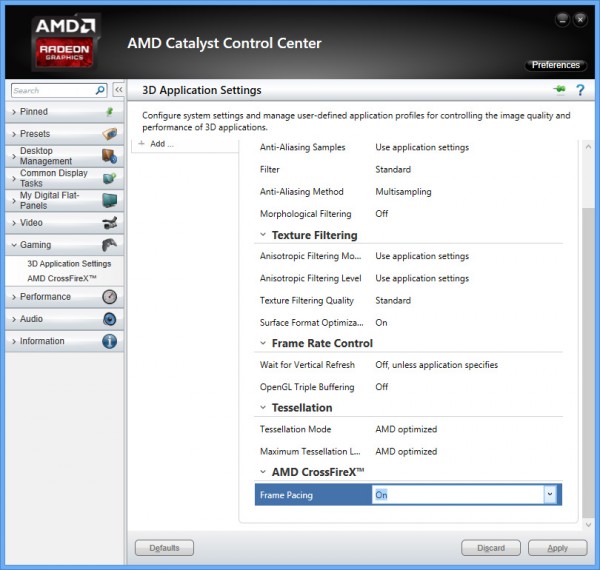AMD Catalyst Drivers: Frame Pacing Fixes for Radeon 7990 and CrossFire
98-Percenter’s make much to do over a driver update that fixes a 1% problem
By Olin Coles
You may have recently heard some news about AMD fixing something wrong with their products, something you probably weren’t even aware was broken. It’s entirely understandable if you missed the headlines, because the fix really only impacted a very small (microscopic) portion of gamers who own the ultra-premium Radeon HD 7990 graphics card or have two 7900-series video cards configured together into a CrossFire set. Still, it was important news for those of us who invested in AMD’s latest discrete graphics solution. By those of us, I really mean an almost unrealistically small number of consumers.
According to the latest (July 2013) Steam hardware survey results, only 0.70 and 0.66% of all computer systems used a Radeon HD 7950 or 7970 video card, however the data does not differentiate standalone and CrossFire configurations. Understandably, the real number of users with CrossFire are much fewer than those with a single card. Unfortunately no data was available for dual-GPU Radeon HD 7990 graphics cards, because it was below the 0.5% threshold.
For the sub-1% of you who are lucky enough to own the ultra-premium Radeon HD 7990 graphics card, or have two Radeon HD 7000-series cards arranged in CrossFire, there’s been a visual issue referred to as stuttering that has been impacting games played with these products under certain conditions. So, essentially, you might be closer to 1/10th of 1%. Regardless, there was a problem synchronizing frame output between two paired graphics processors, and it really annoyed people, most of which were reviewers who were overjoyed to have found a problem in the first place.
I know what you’re thinking: “how could this catastrophic event go unnoticed, and why didn’t Benchmark Reviews cover it with deep technical article featuring twelve-pages of charts and graphs?” Because it wasn’t news, that’s why. This was merely a software bug, and If we stopped writing actual product reviews just to fan flames about the latest driver glitch that needed patching then the writing would never end. This event reminded me of the time I discovered the latest NVIDIA Forceware drivers had dramatically reduced game performance across the board and spent hours testing and writing about it, only to have the problem confirmed and rectified a few days later.
I could probably end this story here, now, and we’d all go back to having productive lives. It would save you and me both some time, but that’s not the point of these editorials. You see, review website should be unbiased, impartial, and apply a common-sense approach whenever we criticize manufacturers. After all, we’re not involved with their production and development process – we merely enjoy the fruits of their labor. It’s our job to test these products and publish our experience so that consumers can make a well-informed decision.
So when I see a long-winded article filled with specialized tests and complex charts, something that could have amounted to an entire video card review, I begin to wonder why so much time and attention would be given to such an insignificant topic. Don’t get me wrong, occasionally we reviewers just like to tinker with benchmarks simply because we’re curious what the hardware will produce, but typically speaking we do so with the purpose of illustrating performance so that consumers like you can decide what to buy. But investigating software bugs ad nauseum?
So here it is: the latest (13.8) AMD Catalyst video card drivers include a ‘frame pacing’ fix that has no notable impact on frame rate (FPS) performance but relieves visual frame stuttering with the Radeon 7990 and CrossFire 7900-series. Does it fix everything? Well, not quite. If 1/10th of 1% of the gamers are using the Radeon HD 7990 or Radeon HD 7900-series cards in CrossFire, imagine how many (or few) people are combining two ultra-expensive Radeon HD 7990’s or three 7900-series cards into a pricey CrossFireX array. By this point we could be down to around 0.0001%, but at any rate that 1/100 of 1% of systems using this rare blend of hardware will be addressed in another upcoming driver release.
So it’s not completely fixed? No, not yet. In addition to the micro-collection of users with Radeon HD 7900-series cards in CrossFireX with 3+ GPUs working together in unison, this frame pacing update does not apply to the remaining handful of gamers using DirectX 9 on Windows XP. It’s hard to believe that AMD neglected to include an Operating System now almost thirteen years old, but when they do return to fix it, rest assured that those with $1000 or more in the latest graphics hardware who continued playing obsolete games using a discontinued and unsupported O/S will be brought whole again.
In the end, you owe it to yourself to read through the myriad of articles that chronicle their writer’s various interactions with AMD, or chart the latest games with-and-without the fix, and then feel satisfied because you’ve just placed yourself on the cutting edge of hardware news and industry information. Or you could feel like you’ve just wasted an hour of your life reading about much to do about nothing relevant to 98% of us. Perhaps I’m making a big deal of a slow news day, but it’s only fair to show both sides of the problem.







Most Recent Comments